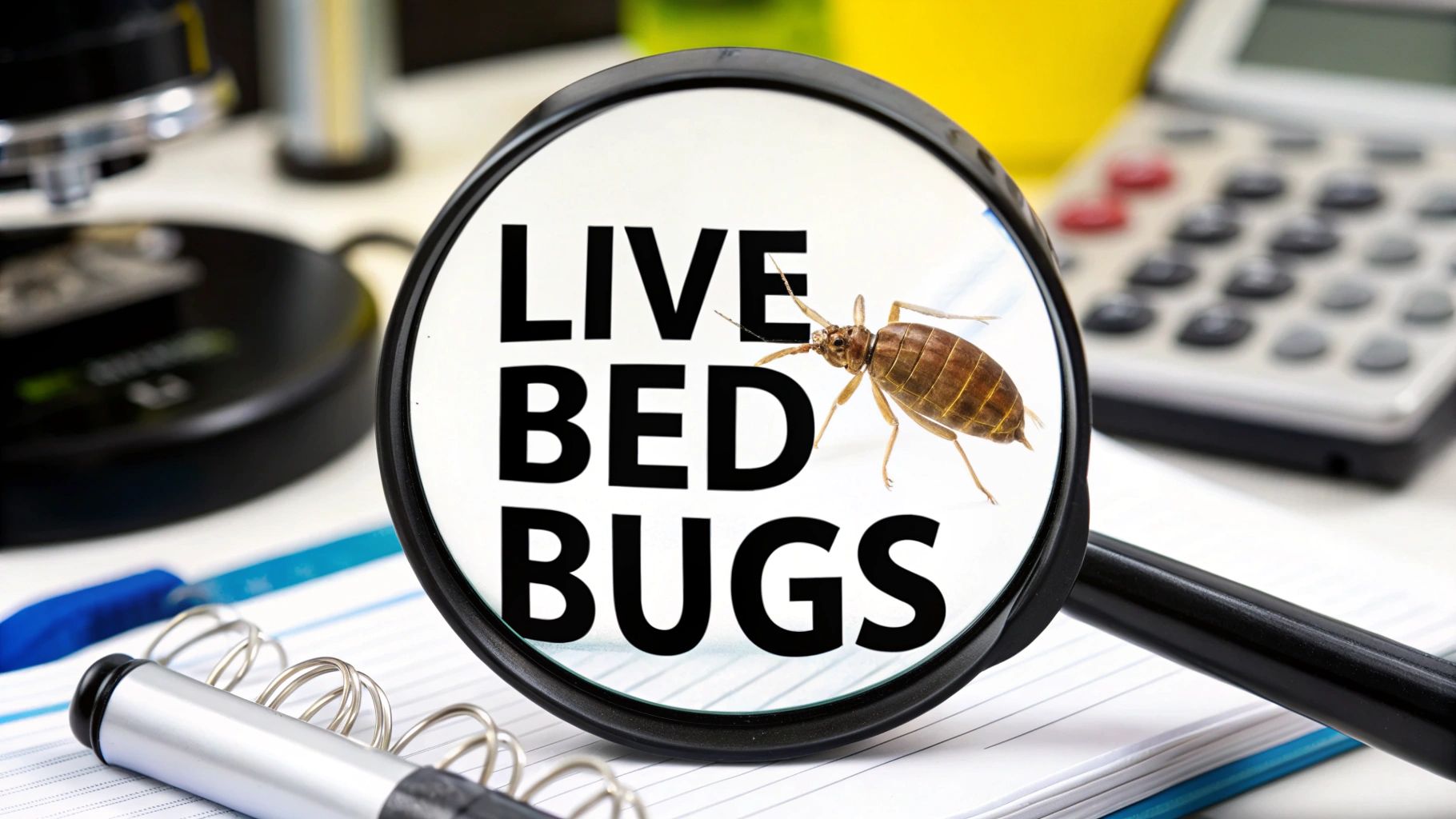
If you want to get a handle on bed bugs—whether for detection, research, or elimination—you have to start with the bug itself. Forget the myths for a moment. These insects are genuine survivalists, with a life cycle and habits that are finely tuned for spreading without being seen. For any of us working in this field, getting that part right is step one.
The Biological Blueprint of a Live Bed Bug
To beat a pest, you have to think like a pest. A live bed bug follows a surprisingly simple, yet brutally effective, life plan. It’s a journey from a nearly invisible egg to a determined, blood-hungry adult. Understanding this cycle isn't just academic; it's the foundation for every pest controller, canine handler, and researcher aiming for real results.
It all starts with the egg. A single female can lay between 200 and 500 eggs in her lifetime. Each egg is only about 1mm long and comes coated in a sticky film. This natural glue lets her tuck them away in safe, hidden spots—think mattress seams, furniture joints, or cracks in the wall. It’s why a simple visual check so often misses the beginning of a serious problem.
From Nymph to Adult: A Journey in Stages
When an egg hatches, usually in 6 to 10 days in the right conditions, a tiny nymph emerges. At this stage, they're basically miniature, see-through versions of the adults. To grow, they have to pass through five distinct developmental phases, which we call instars.
Here’s the critical part: a nymph cannot molt to the next stage without a blood meal. This isn't optional. It means an active food source—us—is absolutely essential for an infestation to take root and expand.
With every molt, the nymph leaves behind a shed skin, or casing. Finding these is a dead giveaway that you're dealing with an active infestation. The whole process, from a hatchling to a fully grown adult, can happen in as little as five weeks if it's warm and food is easy to come by. This is exactly why a small issue can blow up into a massive one so quickly.
The visual below really drives home how quickly things can escalate.
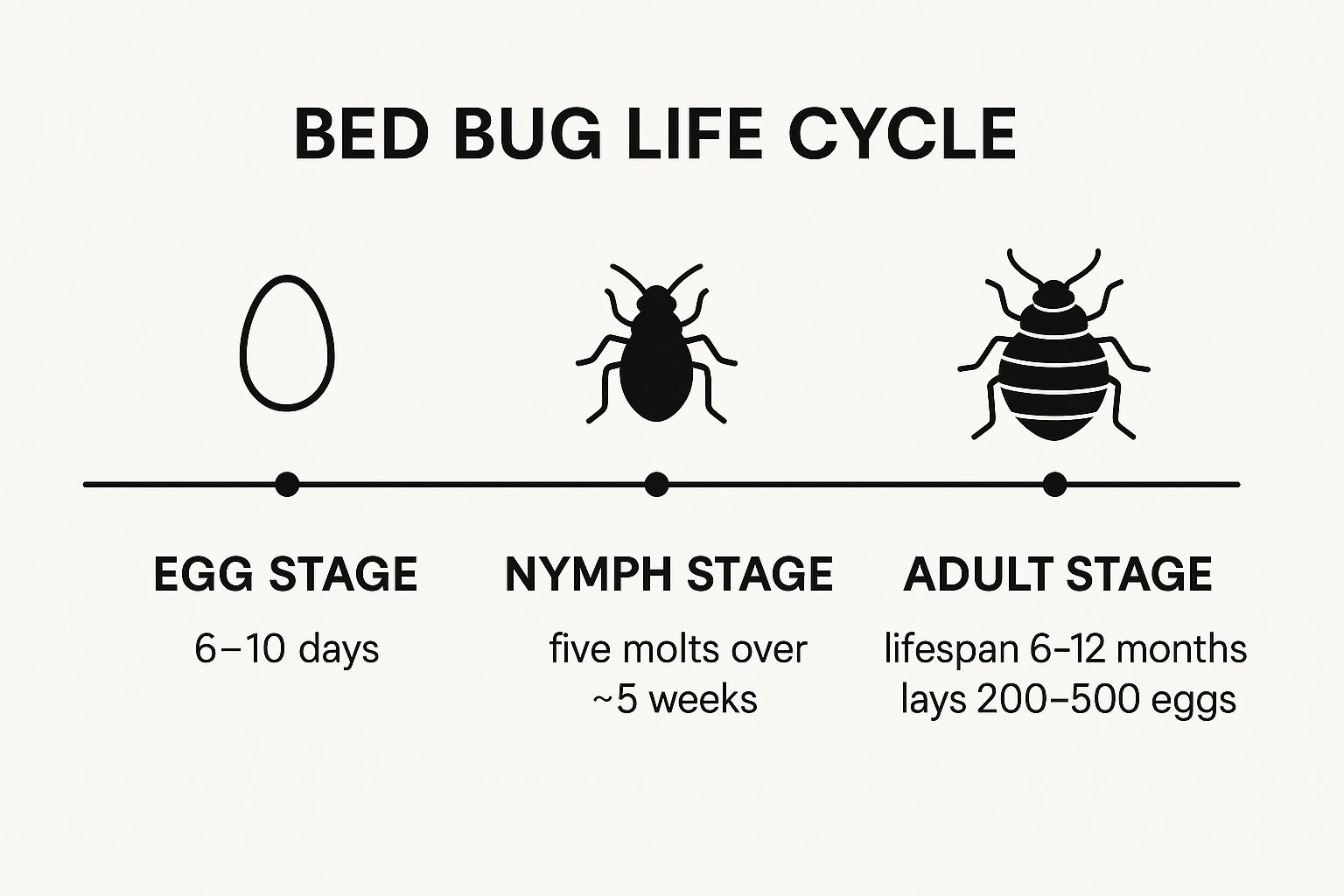
It’s a clear reminder of how one pregnant female can kickstart a major problem in just a couple of months.
To help you keep track, here's a quick breakdown of what to look for at each stage of the bed bug's life.
Bed Bug Life Cycle at a Glance
| Life Stage | Approximate Size | Appearance | Key Characteristics |
|---|---|---|---|
| Egg | 1 mm | Tiny, pearl-white, and oval. | Often found in clusters, secured with a sticky substance. |
| 1st Stage Nymph | 1.5 mm | Translucent, yellowish-white. | Must have a blood meal to molt. |
| 2nd Stage Nymph | 2 mm | Slightly larger, still light in color. | Becomes more visible after feeding (reddish-brown). |
| 3rd Stage Nymph | 2.5 mm | Continues to darken slightly. | Shed skin (casing) becomes more noticeable. |
| 4th Stage Nymph | 3 mm | Getting closer to adult coloration. | Still requires blood to progress. |
| 5th Stage Nymph | 4.5 mm | Reddish-brown, much closer to adult size. | Final molt before reaching adulthood. |
| Adult | 5.5 mm | Flat, oval-shaped, and reddish-brown. | Capable of reproduction and laying eggs. |
This table shows the clear progression from a nearly invisible egg to a fully mature, reproducing adult, highlighting the physical changes you might observe during an inspection.
Thriving in Human Environments
Adult bed bugs are true experts at hiding. They're nocturnal, so they spend their days tucked away in dark, tight spaces. At night, they come out to feed, drawn by the carbon dioxide we breathe out and the heat from our bodies. It’s a simple but effective guidance system.
Their recent comeback is a testament to their adaptability. Warmer global temperatures seem to be speeding up their life cycles, helping them spread even faster. This trend has put cities like Chicago at the top of the list for bed bug infestations for years. You can explore more about the factors behind this seasonal surge.
Once a bed bug finds its target, it uses a sharp, beak-like mouthpart to pierce the skin and feeds for about 5-10 minutes. Then it’s a quick retreat back into hiding. An adult can live for 6 to 12 months and, impressively, can survive for a long time without feeding, just waiting for a host to come back.
Professional Uses for Live Bed Bug Colonies
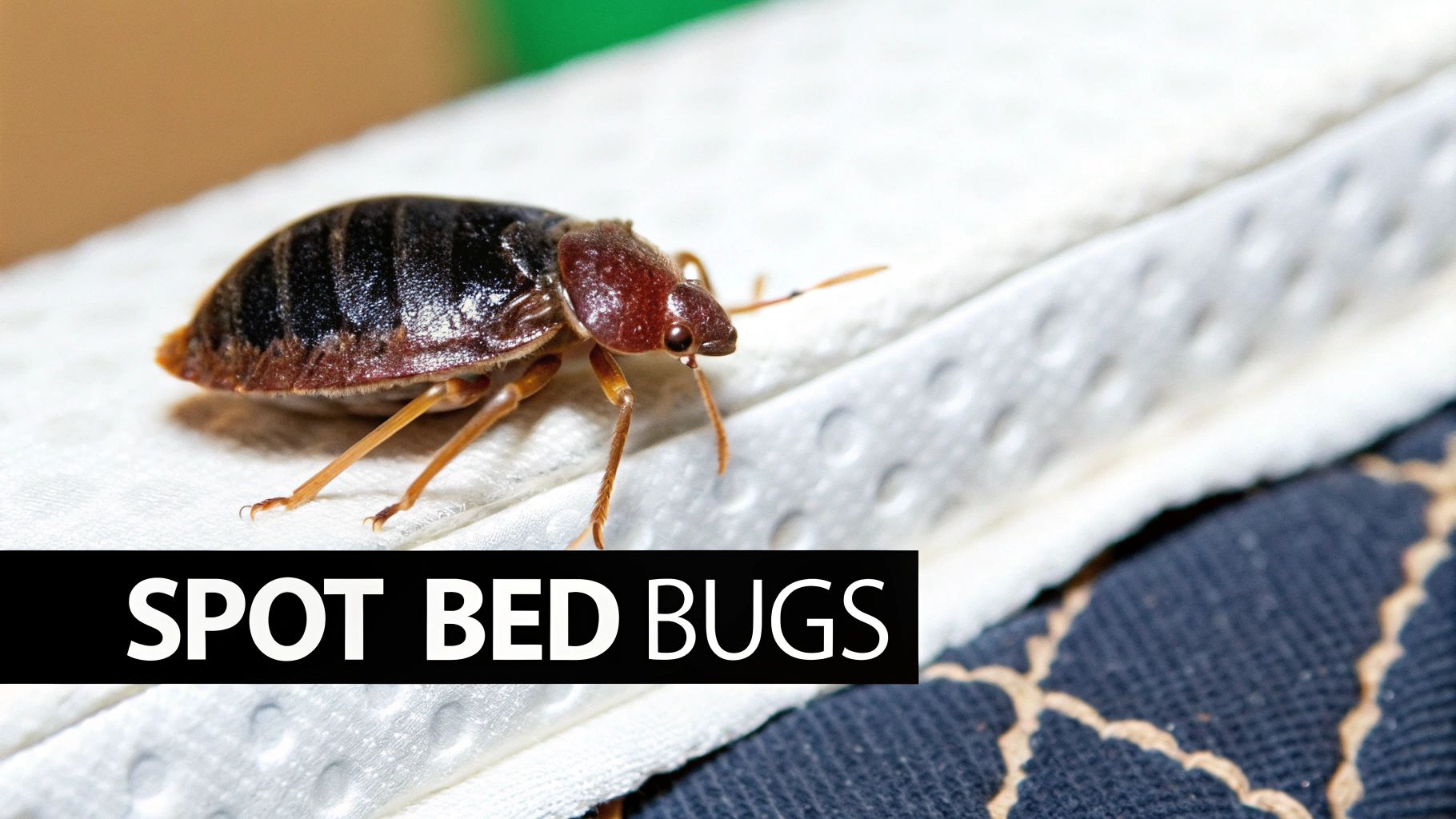
It sounds strange, but raising colonies of live bed bugs is one of the most important things we do to get better at fighting them. These carefully contained populations aren't a threat; they're critical tools that help us innovate and keep people safe. For professionals in several fields, having a reliable source of healthy, living bed bugs is non-negotiable.
From training four-legged detectives to proving a new product actually works, these applications are surprisingly diverse. Without access to live bugs, our ability to detect and wipe out infestations would simply stall.
Training Elite Canine Scent Detectives
One of the biggest jobs for a live bed bug is training canine scent detection teams. A dog’s nose is an incredible instrument, but it needs to be fine-tuned to a very specific scent: the one given off only by living bed bugs and their viable eggs.
Why the emphasis on "living"? Because dead bugs, old skins, and feces all have a different smell. Training a dog on that old evidence would lead to false alerts, causing confusion and unnecessary treatments. You need live bugs to teach a canine the difference between a real, active infestation and the ghosts of a past problem.
A canine trained only on residual evidence might alert on a room that was successfully treated months ago. Using live bugs ensures the dog signals for a current threat, preventing unnecessary treatments and providing clients with accurate, actionable information.
This isn't a one-and-done training session; it's a constant process. Handlers use specially made training aids that let the bug's scent out while keeping the insect safely inside. This is how the dog learns to zero in on the exact hiding spot of an active pest.
Fueling Scientific and Product Research
The pest control industry is in a perpetual arms race with the bugs it’s trying to manage. As bed bugs evolve and develop resistance to the chemicals we use, our researchers have to find and test new ones. That entire process would be impossible without a steady supply of live bed bug colonies.
Scientists expose these contained colonies to new formulas to see how well they work, measuring mortality rates and watching for any changes in bug behavior. This data is the backbone of developing next-gen pesticides that can defeat resistant strains. You can learn more about the diverse services that support this kind of crucial public health research.
But it goes beyond just pesticides. Product developers rely on live bugs to test all sorts of things you might find in a store:
- Mattress Encasements: How do you prove an encasement is truly bed bug-proof? You challenge it with live insects to make sure the zippers and seams are strong enough to keep them from escaping or biting through.
- Monitoring Traps: To build a better trap, you have to know if it actually attracts and catches bed bugs. Companies test different lures and trap designs against live colonies to see what performs best in a real-world scenario.
- Barrier Products: Think of those interceptor traps that go under bed legs. They're tested with live bugs to prove the insects can't climb their slippery surfaces, effectively turning a bed into a safe island.
These professional uses show just how essential a live bed bug can be in the war against infestations. By acting as our test subjects and training partners, these contained colonies help us create the very tools needed to get them out of our homes for good.
Understanding Different Bed Bug Strains
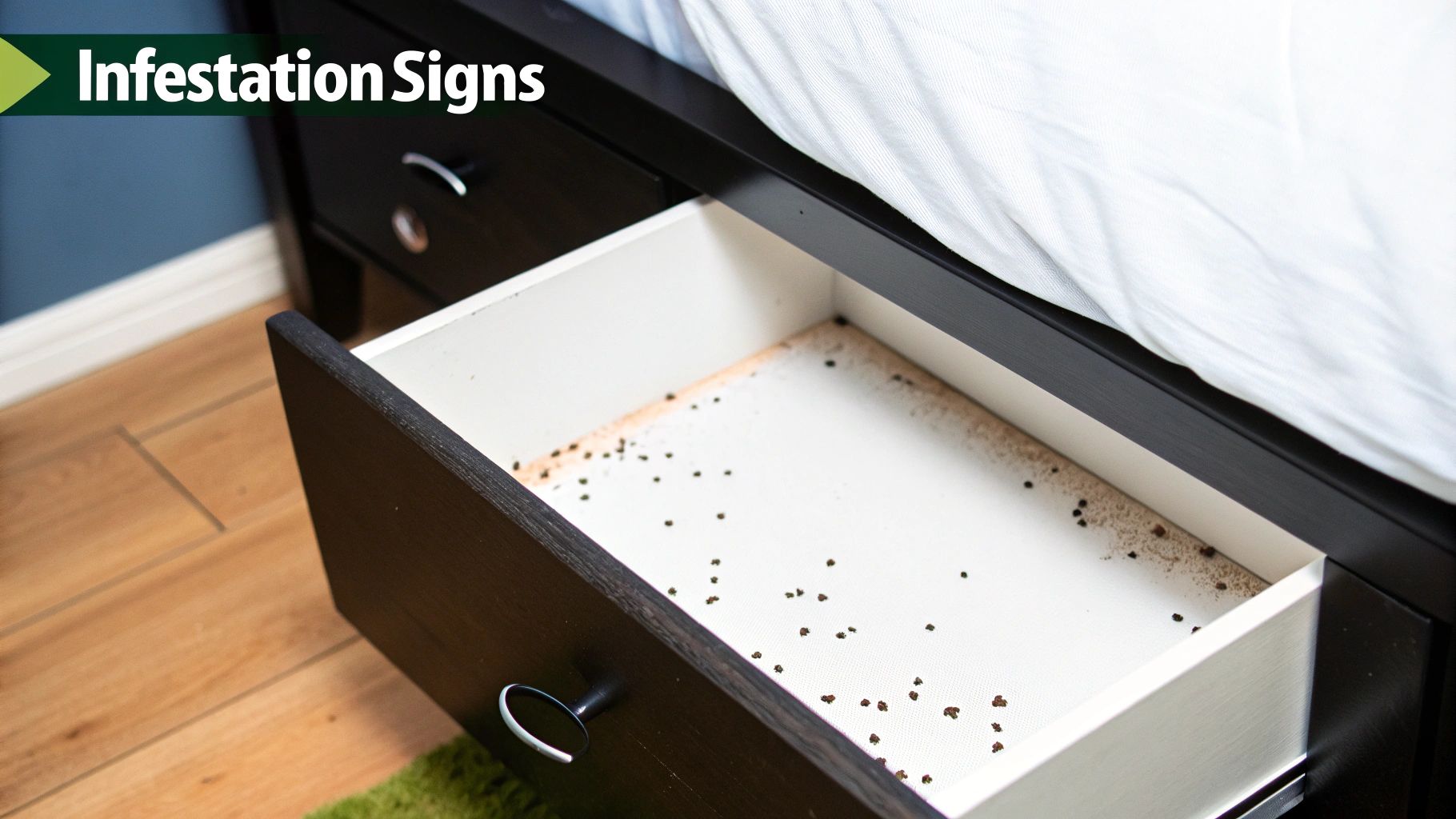
When you're working with a live bed bug for any professional reason, you have to know that not all bugs are the same. Far from it. The specific "strain" you use can make or break your results, whether you’re training a detection dog, testing a pesticide, or designing a new trap.
The biggest difference comes down to one thing: where the bugs came from. You have your lab-reared strains and your field-collected strains.
Think of it this way. A standard lab strain is like a soldier who's only ever trained on a pristine firing range. They’ve lived a sheltered life in a controlled environment for generations. A field-collected strain, on the other hand, is a battle-hardened veteran. It's survived real-world infestations, fought off chemicals, and knows how to stay alive.
This isn't just an academic detail—it has huge practical consequences. For any professional who depends on live bugs, choosing the right strain is the first and most critical step.
The Baseline Lab Strain
The most well-known lab strain is the Harlan strain. This line of bed bugs has been kept in labs since 1973 and has never seen a modern pesticide. Because of this, it’s the perfect scientific control group—a clean slate.
The Harlan strain gives researchers a consistent, predictable baseline. When a lab is testing a new chemical, they almost always start here. If the product can't kill these "soft" targets, it has zero chance against the tougher bugs out in the wild. This makes the Harlan strain essential for the early stages of R&D.
The Reality of Field Strains
Field-collected strains are a whole different animal. We're talking about bugs captured directly from active infestations in homes, hotels, and apartments. For decades, these populations have been hit with everything in the pest control arsenal.
This constant chemical warfare has forced them to evolve. Any bug with a genetic quirk that helps it survive a treatment lives to breed, passing that resistance down. The result? Entire populations of a live bed bug that can simply shrug off chemicals that were deadly just a few years ago.
Testing a new product only against a susceptible lab strain can give you a dangerous false sense of confidence. A pesticide that gets a 100% kill rate in the lab might be practically useless against the resistant field strains that professionals are fighting every single day.
This is exactly why researchers and manufacturers must test their products against resistant field strains for final validation. It's the only way to know if a new solution will actually work for the people who need it most.
Comparison of Bed Bug Strains for Professional Use
So, which strain do you choose? It all comes down to what you’re trying to do. A canine handler needs their dog to find the same kind of tough, resilient bugs they'll encounter on a job, so a field strain is the obvious choice. A university researcher studying a specific genetic mechanism, however, might need a susceptible strain for a clean baseline.
To make it clearer, here’s a breakdown of how these strains stack up.
Comparison of Bed Bug Strains for Professional Use
| Characteristic | Insecticide-Susceptible Strain (e.g., Harlan) | Insecticide-Resistant Strain (Field-Collected) |
|---|---|---|
| Origin | Maintained in a lab environment for decades. | Collected from a recent, real-world infestation. |
| Pesticide Resistance | Highly vulnerable to most common insecticides. | Often highly resistant to pyrethroids and other chemicals. |
| Genetic Makeup | Genetically uniform and predictable. | Genetically diverse and unpredictable. |
| Primary Use Case | Baseline scientific research and initial product screening. | Canine scent training, final product efficacy testing, and resistance studies. |
| Real-World Relevance | Represents a "best-case scenario" for control methods. | Represents the actual challenge faced by pest management professionals. |
At the end of the day, both types of strains are critical for the industry. Lab strains give us the clean, controlled data that science demands. Field strains provide the real-world proof we need to develop genuinely effective pest management solutions.
For any professional needing to buy bed bugs online for their work, understanding this difference is key. It ensures you get the right tool for the job, which leads to better training, more reliable research, and more effective products for everyone.
Safe Handling and Housing Protocols
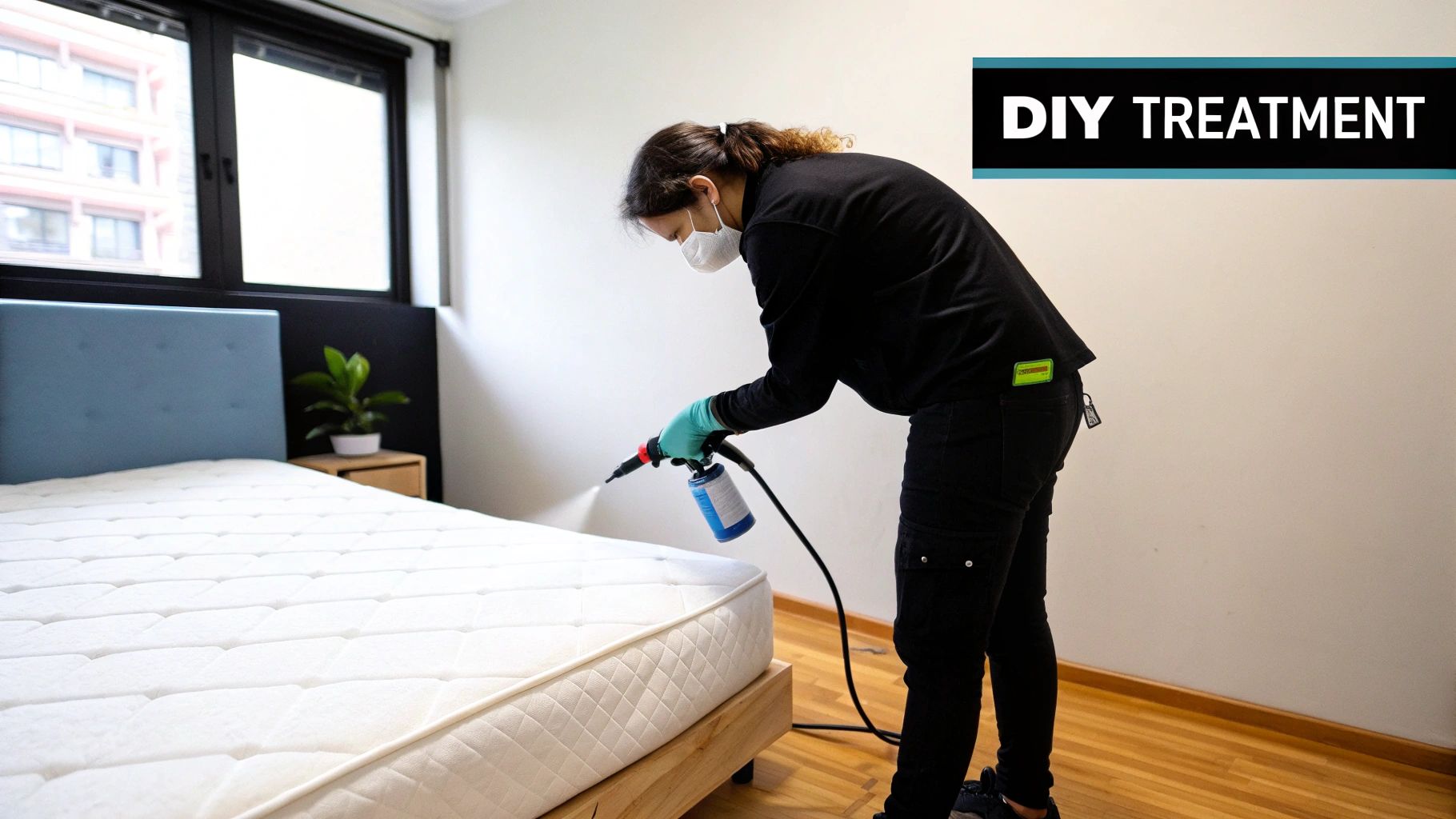
When you're working with a live bed bug colony, you’re taking on a serious responsibility. This goes way beyond just keeping the bugs alive and well; it's about making absolutely sure they stay put. One tiny mistake can lead to an escape, a stray bite, or a contaminated study. Safety has to be the number one priority, no exceptions.
Think of it as running a tiny, maximum-security prison. Every single component, from the jar they live in to the room it sits in, needs to be designed for one thing: preventing escapes.
Building an Escape-Proof Enclosure
The heart of any safe setup is a specialized, escape-proof container. Your average plastic tub from the store simply won't do the job. We use specific containers, often glass jars or ones made of smooth plastic, with one crucial addition: a slippery barrier painted along the inside rim.
This barrier is usually a product like Fluon® (PTFE). When you apply it correctly, it creates a surface so slick a bed bug’s tiny claws can't get any grip. It’s a simple but brilliant way to trap them inside, even when the lid is off for feeding or maintenance.
A secure housing environment is non-negotiable. The goal is zero escapes, which protects both the handler and the integrity of any research or training being conducted. A single escaped female could theoretically start a new infestation, defeating the entire purpose of professional containment.
The container is just the first step. The area around it is just as important. We always place housing jars inside a secondary containment system, like a shallow pan filled with soapy water or lined with a sticky trap. It’s like a moat for insects, designed to catch any bug that somehow beats the odds and gets out of its main home.
Maintaining Optimal Colony Health
To keep a live bed bug colony healthy and productive, you have to get their environment just right. These bugs are surprisingly sensitive, and the right conditions are what make them useful for professional work.
Here are the key factors we control:
- Temperature: Bed bugs do best in a tight temperature range, ideally between 70-80°F (21-27°C). Keeping them consistently warm encourages them to feed regularly and speeds up their reproductive cycle.
- Humidity: We aim for a moderate humidity of around 50-60%. If the air is too dry, they can dehydrate. Too much moisture, on the other hand, can lead to mold growing in their habitat.
Get these two things right, and you'll have a robust colony that gives you reliable results, whether you’re testing a new pesticide or training a detection dog. A stressed, unhealthy colony is an unreliable one.
Feeding and Handling Best Practices
Feeding is the most hands-on part of the job, and it’s where things can go wrong if you're not careful. For safety and ethical reasons, professionals never use live human or animal hosts. We use special artificial feeding systems that are both safe and incredibly effective. These systems use warmed animal blood (often rabbit or chicken blood) inside a device that’s covered with a thin membrane the bugs can pierce to feed.
When it's time to handle the bugs, personal protective equipment (PPE) is a must.
- Nitrile Gloves: These prevent any direct contact with your skin and stop potential bites.
- Fine-Tipped Forceps or Brushes: You need these to move individual bugs gently without crushing or injuring them.
- Lab Coat: This protects your clothes and prevents a stray bug from hitching a ride out of the lab.
By combining secure housing with strict environmental controls and safe feeding methods, we can manage these insects effectively and responsibly.
Navigating Shipping Regulations and Permits
You can't just toss a container of live bed bugs in a box and drop it off at the post office. Shipping these insects is a serious, highly regulated business, governed by strict federal and carrier rules to make absolutely sure they don't get loose. If your work involves live bed bugs, knowing these rules isn't just a good idea—it's a legal requirement.
Think of it like shipping hazardous materials. While they aren't toxic, live insects are a biological material that can cause huge problems if they escape their container. That's why both the United States Department of Agriculture (USDA) and major carriers like FedEx have detailed protocols to keep every shipment locked down. Cutting corners here can land you in serious legal hot water.
The First Hurdle: USDA-APHIS Permits
Before a single bug is packed, the first thing you need is the right permit. In the U.S., the USDA’s Animal and Plant Health Inspection Service (APHIS) is the agency in charge, regulating the movement of plant pests (which includes bed bugs) across state lines.
Anyone shipping or receiving bed bugs for research, training, or educational work generally needs a valid PPQ 526 permit. This system makes sure that only qualified professionals at secure facilities are handling the insects, which minimizes any risk to the public. Getting one isn't a rubber-stamp process; you have to prove you have the right containment setup and safety protocols in place.
The Dual-Containment Packaging Protocol
With the legal paperwork sorted, it's all about the packaging. The whole system is built around one core idea: redundant containment. In other words, you need multiple barriers to make an escape virtually impossible.
Here's how that works in practice:
- Primary Container: First, the live bugs go into a small, secure, and escape-proof vial. This needs to be sealed tight and made from something durable that won’t crack under pressure.
- Secondary Container: That vial is then placed inside a larger, crush-proof container. You’ll want to pack it with absorbent material like cotton or foam to cushion the vial and soak up any potential moisture.
- Secure Outer Box: Finally, the whole thing goes into a standard, sturdy shipping box for transport.
All packages must be clearly and correctly labeled. This usually means a specific "Live Harmless Insects" label, along with your USDA permit numbers displayed prominently. This tells everyone handling the package exactly what’s inside so they can manage it with the proper care.
The sheer economic cost of this pest shows why these rules are so strict. The global bed bug control market is projected to skyrocket to USD 2,038.3 million by 2033, a number that highlights the massive financial and social damage new infestations can cause. You can review the full market analysis to see the global scale of the problem.
Following these shipping and permit rules is a non-negotiable part of professional responsibility. It’s what keeps live bed bugs as a valuable tool for science and training, instead of letting them become an accidental public menace.
The Future of Bed Bug Research and Control
As bed bugs get tougher and more resistant to the chemicals we've relied on for years, the hunt for new solutions is heating up. The entire pest control industry is now looking past standard sprays and diving into the next generation of management techniques. These new methods, all tested in labs on a live bed bug, are our best hope for more effective and lasting ways to deal with infestations.
The real problem we're up against is simple: evolution. Bed bug strains out in the wild have become battle-hardened, easily shrugging off chemicals that used to knock them down. This reality is forcing researchers to get creative and find completely new angles of attack that bypass the bugs' built-up defenses. If we don't innovate, we'll fall behind in the ongoing war against this incredibly resilient pest.
Exploring Next-Generation Technologies
One of the most exciting new frontiers involves using specialized light. With experts predicting a major year-on-year jump in global bed bug infestations, partly fueled by warmer weather, new tools are critical. Ultraviolet (UV) light, for instance, is showing real promise as a control method. Recent studies have shown that UV exposure not only kills bed bugs but also messes with their ability to find a host, and it's particularly good at destroying resistant eggs. You can read more about the projections for bed bug prevalence and UV research to see what's on the horizon.
But light is just one piece of the puzzle. Researchers are exploring other innovative paths:
- Biocontrol Agents: Imagine using a bug's own biology against it. Scientists are investigating fungi and bacteria that are naturally deadly to insects, hoping to introduce a "disease" that can spread through a colony.
- Genetic Research: By mapping the bed bug's entire genetic code, researchers are hunting for its Achilles' heel. This work could lead to highly targeted solutions that disrupt essential functions like digestion or reproduction.
- Advanced Detection: New devices are being developed that can actually "smell" the unique chemical signature—the volatile organic compounds (VOCs)—given off by a live bed bug. Think of it as an electronic nose for instant, on-the-spot detection.
What do all these futuristic ideas have in common? They all depend on having live bed bugs to test them on. Every new technology, from a UV light wand to a potent new fungus, has to prove its worth against healthy, active bed bug colonies to show it can work in the real world.
The Indispensable Role of Live Colonies
At the end of the day, all our progress hinges on the very pests we're trying to control. It's a funny paradox in pest management: to find better ways to get rid of bed bugs, we first have to get really good at keeping them alive and well in a professional lab setting. To learn more about the organizations doing this foundational work, you can check out our About Us page.
These carefully managed colonies of a live bed bug are the essential proving ground for the future. They give us the ability to test, tweak, and perfect the tools that will one day protect our homes and businesses. It's how we ensure our control methods can keep up with the bed bug's own relentless ability to adapt.
Frequently Asked Questions About Live Bed Bugs
We get a lot of questions about handling live bed bugs. Even after you understand their biology, plenty of specific queries pop up. This FAQ gives you direct answers to the most common things we hear from researchers, canine handlers, and pest control pros.
Why Would Anyone Need to Buy Live Bed Bugs?
It sounds strange, right? But professionals don't buy live bed bugs to start an infestation—they buy them to get better at stopping them. These bugs are actually critical tools for very specific jobs where nothing else works.
Here’s who uses them:
- Canine Scent Detection Trainers: Detection dogs have to train on the scent of live bed bugs to be effective. If they only trained on dead bugs or shed skins, they'd give false alerts on old, inactive infestations.
- Scientific Researchers: To create new pesticides that actually work, scientists need live colonies. This is especially true for testing products against tough, insecticide-resistant strains.
- Product Developers: Companies making things like mattress encasements or monitoring traps need live bugs to prove their products can stand up to a real-world threat.
- Educational Institutions: Entomology departments and pest control training programs use live specimens for hands-on learning and demonstrations.
What's the Difference Between a Lab Strain and a Field Strain?
Knowing the difference here is vital. Think of a lab strain as a "clean slate." These bugs, like the common Harlan strain, have been raised in a lab for generations. They are very sensitive to most insecticides and give researchers a predictable baseline to work from.
A field strain is more like a "battle-hardened veteran." We collect these directly from real-world infestations where they've likely been exposed to different chemicals. They've often developed significant resistance, making them essential for testing if a new product will hold up against the resilient bugs people are actually finding in their homes.
Are Special Permits Needed to Ship Live Bed Bugs?
Yes, absolutely. You can't just drop a live bed bug in the mail. Shipping is a tightly regulated process designed to prevent any accidental escapes. In the US, this is handled by the USDA's Animal and Plant Health Inspection Service (APHIS).
You will almost always need a special permit, like the PPQ 526 permit, for shipping live bed bugs across state lines. This proves that both the sender and the receiver have the right containment facilities and know how to handle the insects safely.
Carriers like FedEx also have their own strict rules. They typically require a dual-containment system to make escapes virtually impossible. Not following these rules can lead to serious legal trouble.
How Do Professionals Feed Live Bed Bug Colonies?
To keep a colony healthy, you have to feed it regularly, usually once every 5 to 7 days. For safety and ethical reasons, professionals do not use live human or animal hosts for this. Instead, we rely on special artificial feeding systems.
These systems use a container of warmed animal blood (often rabbit or chicken blood from vet suppliers) covered with a membrane like Parafilm®. The bed bugs can pierce the membrane to feed. This gives them the nutrition they need without putting the handler at risk. For more answers to common queries, you can review our dedicated FAQs page.
For professionals in research, canine training, or product development, having a reliable source of healthy specimens is essential. At Buy Bed Bugs Online, we supply both insecticide-susceptible and resistant field strains to verified facilities. https://buybedbugsonline.com
